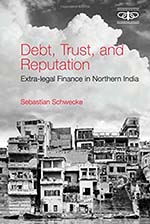The popular image of the village moneylender is often that of a rapacious scoundrel who impoverishes people by lending money at exorbitant rates, a monopolist who retards the development of free market forces, someone who needs to be eliminated in the name of progress. This line has been propagated both by the government (right from the colonial times through enactments such as the Usurious Loans Act) and the Reserve Bank of India. However, the actual practice of moneylending is much more complex. The main thrust of this scholarly work is to argue that we must be wary of over-simplification.
The author, Sebastian Schwecke, is the founding director of the Max Weber Forum for South Asian Studies, Delhi, and often writes, using a multi-disciplinary approach, on South Asian history, economics and society. He has been working and researching in Varanasi for over two decades now and considers himself to be an honorary Banarsi. He had recently co-edited Rethinking Markets in Modern India: Embedded Exchanges and Contested Jurisdiction (Cambridge University Press, 2020).


윈가라오케,송파가라오케,잠실노래방,윈노래방,최저가